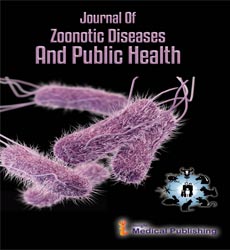Chronic Symptomless Infection Caused by Orthohantavirus
Stan Gray*
Department of Public Health, Imperial College London, London, UK
- *Corresponding Author:
- Stan Gray
Department of Public Health,
Imperial College London,
London,
UK,
E-mail: stan.gray@sg.uk
Received Date: December 03, 2021;Accepted Date: December 17, 2021; Published Date: December 24, 2021
Citation: Gray S (2021) Chronic Symptomless Infection Caused by Orthohantavirus. J Zoonotic Dis Public Health. Vol.5 No.S2:e004.
Description
Orthohantavirus is a species of enveloped, negative-sense and single-stranded RNA viruses in the Hantaviridae family. Members of this species may be called Hantaviruses or Orthohantaviruses. Orthohantavirus is named for the Greek word Ortho- which means "straight" or "true" and for the Hantan River in Republic of Korea, as the first member species of this virus is isolated and identified by Ho Wang Lee in 1976.
Orthohantaviruses typically cause infection with no symptoms in rodents. Humans get infected with hantaviruses whenever they come in contact with rodent saliva, urine or feces and cause life threatening diseases in humans, like hantavirus hemorrhagic fever with renal syndrome (HFRS), or hantavirus pulmonary syndrome (HPS), also referred to as hantavirus cardiopulmonary syndrome (HCPS). The inhalation of aerosolized rodent urine and feces contaminated by hantavirus particles leads to the respiratory illness of HPS.
Humans are associated with two diseases such as hemorrhagic fever with renal syndrome (HFRS) and hantavirus pulmonary syndrome (HPS) by infected with hantavirus. Increased vascular permeability is the most common feature of the two diseases which causes leukocytosis, hypotension and thrombocytopenia. The hemorrhagic fever is far more common of the two but pulmonary illness is more fatal.
Hantaviruses mainly causes hemorrhagic fever with renal syndrome (HFRS) in Asia and Europe. , Based on the virus, clinical presentation varies from subclinical to fatal. Non-specific symptoms such as high fever, chills, headache, backache, abdominal pains, nausea, and vomiting will start after an incubation period of 2-4 weeks. After the initial period, bleeding starts under the skin, accompanied with low blood pressure and further internal bleeding throughout the body. Kidney failure and further health issues begins thereafter, which leads to death.
Hantavirus cardiopulmonary syndrome (HCPS), also called Hantavirus pulmonary syndrome (HPS) is usually caused by Hantaviruses in the Americas. Its time period ranges from 16 to 24 days. Illness initially shows symptoms similar to HFRS. After a couple of days a fluid is bulid within the lungs which cause elevated pulse and non-specific symptoms like sudden onset of progressive, or productive, coughing, shortness of breath occur. After the appearance of severe symptoms cardiovascular shock may occur rapidly and causes death.
Eliminating or minimizing the contact with rodents within the home, workplace, or campsite is the best prevention against contracting hantavirus .Control of rats and mice in areas of human living is vital for disease prevention as the virus is transmitted by rodent saliva, excretions, and bites. General prevention will be achieved by laying down poisons or using natural predators like cats within the home and by removing rodent nests, sealing any cracks and holes in homes where mice or rats could enter, setting traps.
There is no particular treatment for Hantavirus infections but spontaneous recovery is possible with supportive treatment. People with suspected Hantavirus infection should be admitted to a hospital, and given oxygen and artificial ventilation support to assist them breathe during the severe pulmonary stage with acute respiratory distress. Vaccines against Hantaviruses are not approved by the U.S. FDA, but in China and Republic of Korea, whole virus inactivated bivalent vaccines against Hantaan virus and Seoul virus are available. In both countries, the utilization of the vaccine, combined with other preventive measures, has significantly reduced the occurrence of Hantavirus infections.
Open Access Journals
- Aquaculture & Veterinary Science
- Chemistry & Chemical Sciences
- Clinical Sciences
- Engineering
- General Science
- Genetics & Molecular Biology
- Health Care & Nursing
- Immunology & Microbiology
- Materials Science
- Mathematics & Physics
- Medical Sciences
- Neurology & Psychiatry
- Oncology & Cancer Science
- Pharmaceutical Sciences
